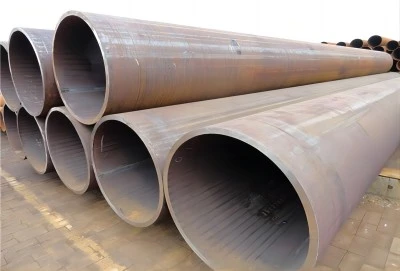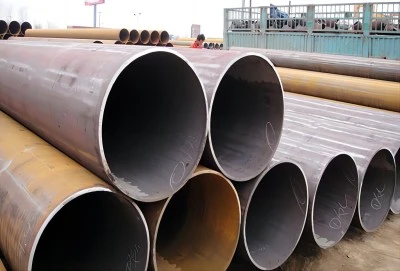Double submerged arc welded (DSAW) pipes have become increasingly popular in various industries due to their exceptional strength, durability, and versatility. As these pipes are often used in challenging environments, it's crucial to understand how they perform under corrosive conditions. This article will explore the corrosion resistance of DSAW pipes, protective measures to enhance their durability, and key applications in harsh environments.
|
|
|
Corrosion Resistance of Double Submerged Arc Welded Pipes
DSAW pipes are known for their superior corrosion resistance compared to many other types of pipes. The double submerged arc welding process creates a strong, uniform weld that is less susceptible to corrosion than traditional welding methods. The process involves welding both the inside and outside of the pipe, which creates a more robust and seamless joint.
In corrosive environments, DSAW pipes demonstrate excellent performance due to several factors:
- Material Selection: DSAW pipes are often made from high-quality steel grades that inherently possess good corrosion resistance. Materials such as stainless steel or corrosion-resistant alloys can be used to further enhance their performance in aggressive environments.
- Weld Quality: The double submerged arc welding process produces high-quality welds with minimal defects. This reduces the likelihood of weak points where corrosion can initiate and propagate.
- Uniform Structure: The welding process creates a uniform structure throughout the pipe, including the weld zones. This uniformity helps to prevent localized corrosion that can occur due to structural inconsistencies.
- Reduced Residual Stress: The DSAW process typically results in lower residual stresses compared to other welding methods. Lower residual stress can contribute to improved corrosion resistance, as areas of high stress are often more susceptible to corrosion.
Despite these inherent advantages, it's important to note that the performance of DSAW pipes in corrosive environments can vary depending on the specific conditions they are exposed to. Factors such as temperature, pressure, pH levels, and the presence of specific corrosive agents can all impact the pipe's longevity and performance.
Protective Measures to Enhance Corrosion Resistance
While DSAW pipes offer good baseline corrosion resistance, various protective measures can be implemented to further enhance their durability in harsh environments:
- Cathodic Protection: This electrochemical technique involves using sacrificial anodes or impressed current systems to protect the pipe from corrosion. By making the pipe surface the cathode in an electrochemical cell, the corrosion process is effectively halted or significantly slowed.
- Protective Coatings: Applying specialized coatings to the exterior and sometimes interior of DSAW pipes can provide an additional barrier against corrosive elements. Common coating materials include epoxy, polyurethane, and fusion-bonded epoxy (FBE).
- Linings: For pipes carrying corrosive fluids, internal linings can be applied to protect the pipe material. These linings can be made from materials such as cement mortar, epoxy, or specialized polymers.
- Corrosion Inhibitors: Chemical inhibitors can be added to the fluids being transported through the pipes to reduce their corrosive effects on the pipe material.
- Regular Inspection and Maintenance: Implementing a robust inspection and maintenance program can help identify and address corrosion issues before they become severe.
- Environmental Control: Where possible, controlling the environment around the pipes (e.g., reducing humidity, removing corrosive agents) can significantly extend their lifespan.
These protective measures are often used in combination to provide comprehensive corrosion protection for DSAW pipes in challenging environments.
Coatings and Linings: Improving Durability of DSAW Pipes
Coatings and linings play a crucial role in enhancing the durability of double submerged arc welded pipes, especially in corrosive environments. Let's explore how these protective layers contribute to the longevity and performance of DSAW pipes:
External Coatings
External coatings serve as the first line of defense against environmental corrosion. They work by creating a barrier between the pipe material and corrosive elements in the surrounding environment. Some key benefits of external coatings include:
- Barrier Protection: High-quality coatings form an impermeable barrier that prevents corrosive substances from reaching the pipe surface.
- Electrical Insulation: Many coatings provide electrical insulation, which can enhance the effectiveness of cathodic protection systems.
- UV Resistance: For above-ground applications, coatings can protect the pipe from UV degradation.
- Abrasion Resistance: Some coatings offer excellent resistance to physical damage, protecting the pipe during handling and installation.
Common types of external coatings used on DSAW pipes include:
- Fusion-Bonded Epoxy (FBE)
- Three-Layer Polyethylene (3LPE)
- Three-Layer Polypropylene (3LPP)
- Polyurethane
- Coal Tar Epoxy
Internal Linings
Internal linings are crucial when the pipe is carrying corrosive fluids. They protect the inner surface of the pipe from chemical attack and can also improve flow characteristics. Benefits of internal linings include:
- Chemical Resistance: Linings can be selected to resist specific chemicals or pH ranges that the pipe will be exposed to.
- Improved Flow: Smooth linings can reduce friction, improving flow efficiency and reducing the risk of material buildup.
- Extended Lifespan: By protecting the base material from corrosion, linings can significantly extend the service life of the pipe.
Common types of internal linings for DSAW pipes include:
- Cement Mortar Lining
- Epoxy Lining
- Polyurethane Lining
- Glass Flake-Filled Polyester Lining
The selection of the most appropriate coating or lining depends on various factors, including the specific corrosive environment, operating temperatures, pipe material, and intended service life. It's crucial to consult with coating specialists and consider industry standards when selecting protective measures for DSAW pipes.
Key Applications of DSAW Pipes in Harsh Environments
Double submerged arc welded pipes find extensive use in various industries, particularly in applications involving harsh or corrosive environments. Their robust construction and enhanced corrosion resistance make them ideal for challenging conditions. Here are some key applications:
- Oil and Gas Industry: DSAW pipes are widely used in offshore and onshore oil and gas pipelines. They can withstand the corrosive effects of crude oil, natural gas, and associated chemicals, as well as harsh marine environments.
- Chemical Processing: In chemical plants, DSAW pipes are used to transport corrosive chemicals and slurries. Their resistance to various chemicals makes them suitable for handling acids, alkalis, and other reactive substances.
- Water Treatment: DSAW pipes are employed in desalination plants and water treatment facilities where they may be exposed to saltwater, chlorides, and other corrosive agents.
- Mining Industry: These pipes are used to transport abrasive slurries and corrosive mine drainage. Their durability and wear resistance make them ideal for these demanding applications.
- Power Generation: In power plants, DSAW pipes are used in cooling systems, flue gas desulfurization units, and other areas where corrosion resistance is critical.
- Pulp and Paper Industry: The corrosive chemicals used in paper production necessitate the use of robust piping systems, making DSAW pipes a popular choice.
- Marine Applications: DSAW pipes are used in various marine applications, including offshore platforms, subsea pipelines, and port facilities, where they must withstand corrosive seawater and marine organisms.
- Geothermal Energy: In geothermal power plants, DSAW pipes are used to transport hot, mineral-rich fluids that can be highly corrosive.
In all these applications, the superior corrosion resistance and structural integrity of DSAW pipes, combined with appropriate protective measures, ensure long-term performance and reliability even in the most challenging environments.
Contact Longma
Double-submerged arc-welded pipes have proven to be exceptional performers in corrosive environments across various industries. Their inherent corrosion resistance, coupled with advanced protective measures like cathodic protection, specialized coatings, and linings, make them a reliable choice for challenging applications. From the depths of offshore oil fields to the harsh conditions of chemical processing plants, DSAW pipes continue to demonstrate their value in ensuring safe, efficient, and durable fluid transportation.
As industries continue to push the boundaries of what's possible, the demand for high-performance piping solutions will only grow. Double-submerged arc pipes, with their remarkable combination of strength, durability, and corrosion resistance, are well-positioned to meet these evolving needs.
If you're looking for robust piping solutions for your next project, especially in corrosive or harsh environments, consider the benefits of double submerged arc welded pipes. At Longma Group, we specialize in manufacturing high-quality DSAW pipes that meet the most stringent industry standards. Our team of experts is ready to assist you in selecting the right pipe specifications and protective measures for your specific application. Don't let corrosion compromise your operations. Contact us today at info@longma-group.com to learn how our DSAW pipes can provide long-lasting performance in even the most challenging conditions.














